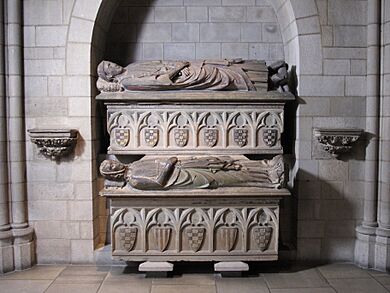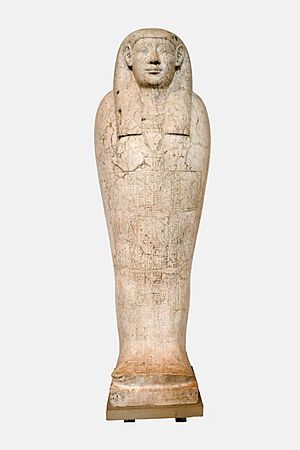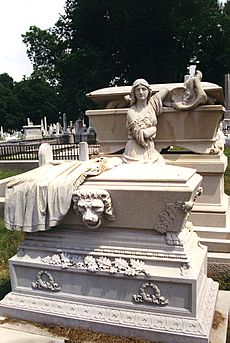Sarcophagus facts for kids

A sarcophagus is a special type of coffin, usually carved from stone. Unlike most coffins, sarcophagi (the plural of sarcophagus) are often displayed above ground instead of being buried.
The name "sarcophagus" has a fascinating origin. It comes from two Greek words: sarx, which means "flesh," and phagein, which means "to eat." Together, they mean "flesh-eater." This name came from an ancient belief that a special kind of limestone could help a body break down naturally and quickly.
Contents
The History of Sarcophagi
Sarcophagi have been used by different cultures for thousands of years. They were usually made to be seen, acting as a lasting monument for the person inside.
Ancient Egypt: The First Stone Coffins
The first people to use stone sarcophagi were the pharaohs of ancient Egypt. This tradition started during the 3rd dynasty, around 2686 to 2613 BC. These early sarcophagi were built to protect the pharaoh's body for the afterlife.
Greek and Roman Styles
The ancient Greeks also created beautiful sarcophagi. Some, like the Klazomenian sarcophagi, were made of clay and decorated with detailed paintings. A famous example is the Hagia Triada sarcophagus, which is covered in colorful paintings called frescoes.
The ancient Romans made sarcophagi popular, especially during the reign of Emperor Trajan. Roman sarcophagi were often made of stone, but sometimes metal or plaster was used. They were famous for their detailed carvings, which often told stories from mythology or the person's life. Because they were usually placed against a wall inside a tomb, only three sides were decorated.
Use in Christian Europe
When Christianity became more common, many people preferred to be buried underground. This meant sarcophagi were used less often. However, they remained popular for important people like kings, queens, and church leaders.
During the High Middle Ages, many sarcophagi had a sculpture of the person lying on the lid. This sculpture is called a tomb effigy. Simpler sarcophagi were often placed in crypts, which are stone chambers beneath a church. One of the most famous collections of sarcophagi is in the Imperial Crypt in Vienna, Austria.
New Trends in Later Centuries
In later centuries, churches started to run out of space for large stone sarcophagi. This led to the creation of "false sarcophagi," also known as chest tombs.
These looked just like real sarcophagi on the outside, but they were empty. They were placed on top of the ground directly over the spot where a person was buried. This style became very popular in Britain during the 18th and 19th centuries. Having a false sarcophagus was a way for a family to show their wealth and social status.
Sarcophagi in the United States
False sarcophagi also became popular in American cemeteries in the late 1800s. For a time, they were one of the most common types of memorials. They remained in use until the 1950s.
Eventually, they became less common because cemeteries started using flat grave markers. Flat markers make it much easier to mow the grass and take care of the grounds. The Warner Monument in Philadelphia is a famous example from this period. It includes a sculpture that shows the spirit of the person leaving the body.
Sarcophagi Around the World
Sarcophagi are not just a European tradition. Different forms have been found all over the world.
- Vietnam: In the Mekong Delta, some families place their loved ones in sarcophagi near their homes. This allows them to easily visit and honor their ancestors.
- Indonesia: On the island of Sulawesi, a traditional type of sarcophagus is called a waruga.
- India: Archaeologists have found sarcophagi in India that are over 2,000 years old.
- Spain: Ancient sarcophagi from the Phoenicians and early Christians have also been discovered in Spain.
Interesting Facts about Sarcophagi
- While we most famously associate sarcophagi with Egyptian pharaohs like Tutankhamun, they were used by various ancient cultures, including the Etruscans, Romans, and Greeks.
- The intricate carvings and paintings on sarcophagi served as a guidebook for the afterlife to help the deceased navigate the dangers of the underworld and reach paradise.
- The granite sarcophagus in the King's Chamber of the Great Pyramid of Giza weighs an estimated 80 tons (over 160,000 lbs). How it was precisely placed in the small chamber remains a topic of debate and awe among archaeologists.
- The "Curse of the Pharaohs" legend was fueled by a sarcophagus. The famous "curse" was sparked by the death of Lord Carnarvon shortly after the opening of Tutankhamun's tomb. A key part of the legend was an inscription supposedly found on the pharaoh's sarcophagus: "Death shall come on swift wings to him who disturbs the peace of the king." In reality, no such inscription was ever officially recorded by the excavators.
- Not all sarcophagi were stone or gold. Many Egyptian "everyday" sarcophagi were crafted from wood, painted to resemble more expensive materials.
See also
 In Spanish: Sarcófago para niños
In Spanish: Sarcófago para niños





